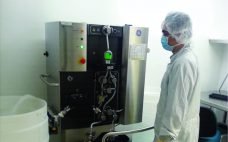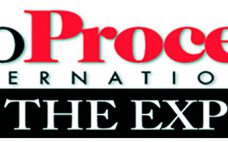It is no big revelation that publishing is changing. How people prefer to read and access information is in some ways a demographic conundrum and in other ways an expected technology-driven evolution. Recognizing those changing attitudes and in honor of our 15th anniversary year as a publication, for 2017 BPI is planning to both adapt to and further drive business and publishing trends in ways that truly meet the information needs of our readers around the world. We simply didn’t…
December 2016
December Spotlight
BPI Advisor Will Be Missed Thomas J. Pritchett, PhD (1950– 2016), was a member of the BioProcess International advisor board since its founding. He also was founder, publisher, and editor of the BioQuality Newsletter and provided decades of analytical and quality control training to many people in the biopharmaceutical industry, both on the industrial and regulatory sides. Pritchett always provided insightful, well–thoughtout approaches to implementing current good manufacturing practices (CGMPs) under all conditions, ranging from virtual to global companies. He…
BioPhorum Operations Group Technology Roadmap, Part 1: Four Trends Shaping the Future of the Industry
What prompts over 100 biopharmaceutical manufacturers, leading academics, supply partner R&D heads, regulators, and worldwide regional hubs to get involved in a major project? It’s when that project identifies the future technology needs of the biopharmaceutical manufacturing industry and accelerates its collective innovation. In February 2015, the BioPhorum Operations Group (BPOG) Technology Roadmapping steering committee met in Washington DC to create the first “technology roadmap” for the biopharmaceutical manufacturing industry. The biopharmaceutical market has been experiencing dramatic changes: explosive growth…
India’s Next Steps: Quality Improvements Target International Markets
India’s position as a global participant in small-molecule generic drugs, vaccines, and enzymes has been proven over decades. The country is one of the most populous and fastest-growing regions in the world, both economically and technically. But India’s potential as a biologics participant has not been realized. Its competence as a global biologics producer has not yet caught up. Global industry concerns regarding the country’s position in the (bio) pharmaceutical industry haven’t changed much over the past eight years since…
Funding for Life-Science Ventures: Accelerating Innovation in Tools and Services
As a cofounder of Wave Biotech (now a division of GE Healthcare), my partners and I often struggled with critical choices regarding partnering and funding opportunities. Every new, attractive, and potentially disruptive technology will court attention once it experiences some modest adoption and acceptance, even while attempting to “fly under the radar” of major players. The challenge for life-science entrepreneurs is how best to navigate those decisions and select the right path as company founders. Weighing and evaluating potential partners…
The 2016 BPI Awards: Honoring the People, Organizations, and Technologies in Global Biotherapeutics
Since 2003, the mission of BioProcess International has been to connect biopharmaceutical scientists and decision makers to the science, technology, and expertise that can positively influence and improve existing bioprocesses. Our BioProcess International Awards were created in 2012 to mark the magazine’s 10-year anniversary. They allow us to reflect on and help honor the time and investment companies put into researching, developing, and launching biopharmaceutical products, technologies, and services to deliver better, more efficient treatments and increased hope to a…
Postapproval Changes for Biopharmaceutical Drug-Substance and Drug-Product Manufacture: Regulatory Complexity and Impact
Pharmaceutical products save or improve the lives of millions of people each year. Thorough regulatory review of chemistry, manufacturing, and controls (CMC) information is critical to ensure drug product safety, quality, and efficacy as well as to secure patients’ continuous access to such products. But achieving all of that at an effective cost is difficult. Companies race to launch products to patients as soon as possible after clinical efficacy is demonstrated. Biomanufacturers often need to make changes such as increasing…
Reducing Clinical-Phase Manufacturing Costs: Collaborating for Savings without Compromising Quality or Performance
In downstream purification of monoclonal antibodies (MAbs), the single greatest contributor to manufacturing costs is the expensive capture step typically based on protein A affinity chromatography. Almost since its introduction to bioprocessing, efforts have been made to reduce the cost of this step. Several alternative ligands have been promulgated as potential replacements for protein A, but they have proven difficult to adopt and scale up. Supplier companies have pushed for increases in capacity and economics, but those are always accompanied…
Medium and Feed Development: Beyond Maximizing Protein Titer to Optimizing Glycan Distribution and Simplifying Process Scale-Up
Serena Fries Smith, associate director of global technical engagements for Thermo Fisher Scientific, covered advantages in feed solutions in the context of current industry trends in an early November webinar. Leveraging feed designs and strategies can optimize glycosylation of complex proteins, simplify scale-up of fed-batch processes, and improve expression titers. Smith’s Presentation In 1994, the average expression titer was 0.5 g/L. Thanks in part to improvements in culture feeding, titers had increased to 1.3 g/L in 2004. By 2014, they…
Enabling Custom Solutions for Downstream Processing of Future Therapies: An Adenoassociated Virus Case Study
Orjana Terova is a purification product manager in the bioproduction division of Thermo Fisher Scientific. In a BPI webinar on 9 December 2016, she discussed the company’s custom resin program for purification of biological products. Thermo Fisher Scientific has dedicated a pilot-plant facility for this program. Terova’s Presentation Speed is the main development driver in downstream processing, but quality and efficiency are always critical. Purification processes need the highest resolution, capacity, salt tolerance, and operation speed possible. Consistency and reproducibility…









